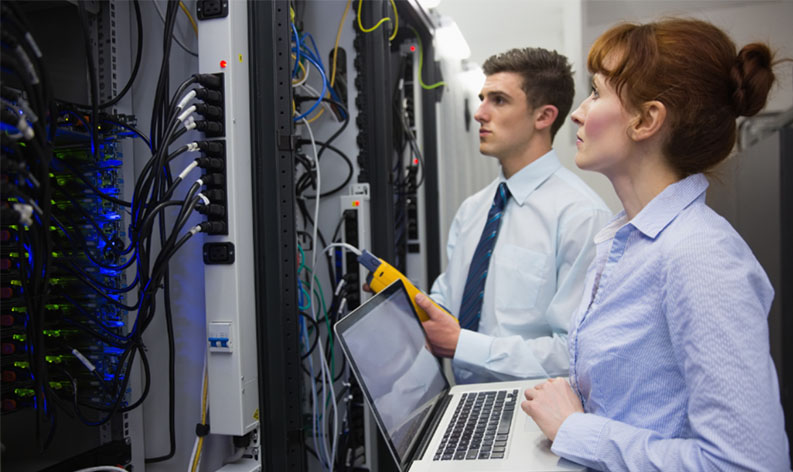
Data center racks are becoming denser, with IT equipment and a supporting infrastructure that consumes more power than ever before. When power was cheap, few companies gave any thought to how well they managed their power resources. But with electricity costs reaching historic highs, companies have had no choice but to investigate energy efficient technologies and practices that can help lower those costs and keep them competitive in a tighter global market.
With this in mind, we have put together a list of top five best practices to help you efficiently manage your data center racks in this continually changing and cost-conscious environment.
1. Monitor Your Environment for Energy and Cost Savings
Data centers have a tendency to overcool their facilities by several degrees just to err on the side of caution. But take note: Gartner has determined that environmental sensors can save you up to four percent in energy costs for every degree of upward change in the baseline temperature.
Temperature sensors at the rack inlet provide far more accurate, real-time views of data center temperatures compared to CRAC readings alone. This information can be used to make the cooling system more efficient (for example, by shutting down CRAC units as needed).
Other sensors, including humidity, water leak, air pressure, and airflow, can also be integrated with a DCIM software solution to improve data center availability, rack uptime, and security.
2. Measure Power More Accurately to Increase Uptime
Power metering is critical when it comes to managing your data center racks. Measuring power enables you to manage the energy usage and complete productivity of your data center operations. Managing your power will help to increase uptime and provide cost savings.
Many data centers feed power directly from panels to blade servers. Although effective in distributing power, this and similar traditional approaches to power metering and monitoring fall short because they fail to provide information about how much actual power devices are drawing.
Forward-looking data center managers are increasingly using iPDUs to more accurately measure power. These intelligent rack power distribution units are an effective way to poll devices at the rack level and determine exactly how much power is being drawn. They offer real-time remote power monitoring of current (amps), voltage, power (kVA, kW) and energy consumption (kWh) with +/- 1% billing-grade accuracy down to the individual outlet level.
Collecting power consumption data can also allow you to utilize a billback program, study analytics and trends over time, and forecast future needs.
3. Plan and Manage Your Rack Space for Effective Asset Management
Planning and managing your data center racks can be stressful and confusing. Using Excel and Visio to track your data center assets only makes your tasks more time consuming and difficult. These outdated tools do not provide the detailed information you need to make informed decisions. In fact, the challenges they present often keep data center managers from finding hidden or underutilized power, cooling, and space.
A DCIM solution can monitor power and environment trends over time to reveal areas where new equipment can be safely provisioned to. But what if you don’t have enough space? A DCIM tool can help you identify servers that are good candidates for consolidation or decommissioning. It can even help you to power off servers in non-production environments when they’re not in use. In either case, you’re able to free up space in racks and save on near-term capital expenditures for new racks, or worse yet, a potential new facility project.
4. Take Physical Measures to Secure Your Racks
Threats to sensitive data, especially for financial services, healthcare, and retail organizations, don’t only come virtually. It’s equally important to prioritize the physical security of data center racks.
To ensure your data center rack’s security, access to the facility site should be limited to a select number of employees. Video surveillance, security guards, and electronic access control devices are also proper steps to take to protect your data center racks against unauthorized access.
If located within a cabinet, data center racks also can be secured by locking the door of the cabinet they are contained in. User-based permissions can ensure that only authorized users can view, add, modify, or delete assets contained in your data center.
5. Implement DCIM Software with a Single Pane of Glass to Manage All Data Center Racks
Managing all data center racks, especially in large data centers, can be a cumbersome process. In particular, reporting and viewing all of the information you need to manage the data center can require multiple steps and clicks. Traditional methods of accessing this information frequently do not allow for the necessary level of detail for accurate and timely management, or if they do, the information is often difficult to access and update.
A DCIM system solution will increase productivity in the management of data center racks with features that make it easy to get data center information in and out for processing and decision making. A web browser single pane of glass and visualization tools provide an overview of your data center assets, and drill-downs of detailed information enable easy management of equipment, power, network, and connections from one central place.
The integration of DCIM with sensors, ticketing systems, and CMDBs provides accurate and real-time data on space, power, and environment for data center racks.
Want to find out how DCIM can help you better manage your data center racks? Take our DCIM software for a quick spin today.
Originally published July 27, 2016; Update August 24, 2018.




























